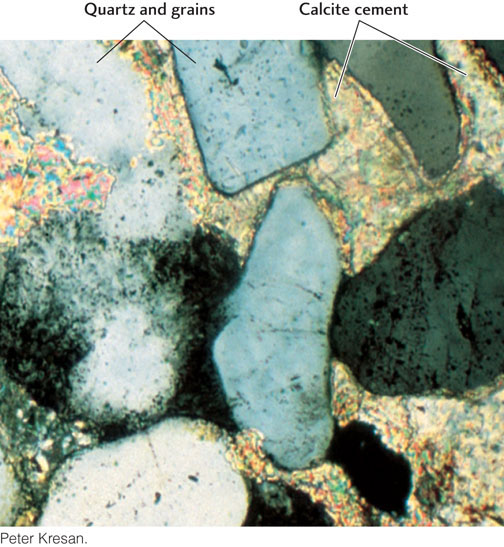Burial and Diagenesis: From Sediment to Rock
Most of the clastic particles produced by weathering on land end up deposited in various sedimentary basins in the oceans. A smaller amount of siliciclastic sediment is deposited in sedimentary environments on land. Most chemical and biological sediments are also deposited in ocean basins, although some are deposited in lakes and wetlands.
Burial
Once sediments reach the ocean floor, they are trapped there. The deep seafloor is the ultimate sedimentary basin and, for most sediments, their final resting place. As the sediments are buried under new layers of sediments, they are subjected to increasingly high temperatures and pressures as well as chemical changes.
Diagenesis
After sediments are deposited and buried, they are subject to diagenesis—the many physical and chemical changes that result from the increasing temperatures and pressures as they are buried ever deeper in Earth’s crust. These changes continue until the sediment or sedimentary rock is either exposed to weathering or metamorphosed by more extreme heat and pressure (Figure 5.16).

Temperature increases with depth in Earth’s crust at an average rate of 30°C for each kilometer of depth, although that rate varies somewhat among sedimentary basins. Thus, at a depth of 4 km, buried sediments may reach 120°C or more, the temperature at which certain types of organic matter may be converted to oil and natural gas (see Practicing Geology). Pressure also increases with depth—on average, about 1 atmosphere for each 4.4 m of depth. This increased pressure is responsible for the compaction of buried sediments.
131
Buried sediments are also continuously bathed in groundwater full of dissolved minerals. These minerals can precipitate in the pores between the sediment particles and bind them together—a chemical change called cementation. Cementation decreases porosity, the percentage of a rock’s volume consisting of open pores between particles. In some sands, for example, calcium carbonate is precipitated as calcite, which acts as a cement that binds the grains and hardens the resulting mass into sandstone (Figure 5.17). Other minerals, such as quartz, may cement sands, muds, and gravels into sandstone, mudstone, or conglomerate.

The major physical diagenetic change is compaction, a decrease in the volume and porosity of a sediment. Compaction occurs as sediment particles are squeezed closer together by the weight of overlying sediments. Sands are fairly well packed during deposition, so they do not compact much. However, newly deposited muds, including carbonate-containing muds, are highly porous. In many of these sediments, more than 60 percent of the volume consists of water in pore spaces. As a result, muds compact greatly after burial, losing more than half their water.
132
Both cementation and compaction result in lithification, the hardening of soft sediment into rock.